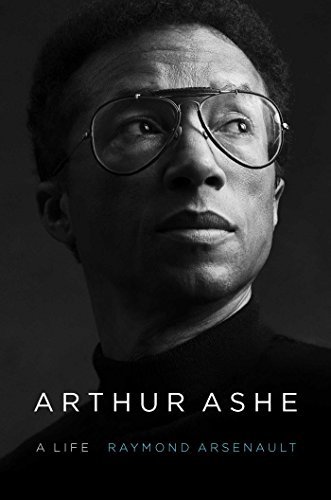
Arthur Ashe
A Life
فرمت کتاب
ebook
تاریخ انتشار
2018
نویسنده
Raymond Arsenaultناشر
Simon & Schusterشابک
9781439189061
کتاب های مرتبط
- اطلاعات
- نقد و بررسی
- دیدگاه کاربران
نقد و بررسی

May 28, 2018
The first black superstar in men’s tennis makes a significant mark off the court in this inspiring but staid biography. Historian Arsenault (Freedom Riders) follows Ashe’s career through epochal shifts in tennis and society as Ashe practiced on segregated courts in Virginia in the 1950s, matured as the sport opened fully to African-Americans in the 1960s, then became an antiapartheid activist and integrated the South African Open in 1973 to acclaim, but also complaints that he should have boycotted it instead. He also navigated tennis’s transition from amateur pastime to big-money, big-ego spectacle, helping to found a players’ union but mourning the erosion of the sport’s genteel manners, which he stoutly upheld. Ashe even made his untimely death from AIDS serve a purpose by raising awareness of the disease. Arsenault’s narrative is well-researched and exciting in a few on-court showdowns and political confrontations, but for most of its great length Ashe is such an unflagging paragon of sportsmanship and social responsibility that he comes across as rather bland. It’s only with the appearance of Jimmy Connors, whom Ashe beat for the Wimbledon title, and John McEnroe, whom he coached on the Davis Cup team, that drama erupts as the two foul-mouthed, tantrum-throwing divas ruffle Ashe’s decorum. Readers will find his saga admirable, but not very taut.

June 1, 2018
A well-informed doorstop biography of Arthur Ashe (1943-1993).Arsenault (Southern History/Univ. of South Florida, St. Petersburg; The Sound of Freedom: Marian Anderson, the Lincoln Memorial, and the Concert that Awakened America, 2009, etc.) uses his vast knowledge of civil rights history to properly situate the pioneering black tennis star within American and world history. Just short of 50, Ashe died from complications related to AIDS, "a disease he acquired from a blood transfusion administered during recovery from heart surgery in 1983." During his relatively short life, Ashe not only integrated big-time men's tennis; he also served as a scholar of black history, a civil rights activist, an ethicist, and a diplomat without a portfolio. In the early stages of the massively detailed chronology, the author's subject can seemingly do no wrong, but as the narrative progresses, Ashe begins to demonstrate his flaws, making decisions that prove unpopular or even counterproductive. One of the thorniest issues involved whether tennis professionals--especially those considered nonwhite--should boycott matches in apartheid-ridden South Africa. Ashe believed that an eternal boycott bordered on a simplistic nonsolution to racism, so he repeatedly sought a visa from the apartheid government. Arsenault chronicles Ashe's childhood rise from the segregated tennis courts of Richmond, Virginia, to less-discriminatory amateur play in other locales. Despite Ashe's extremely slight build as a child, he regularly defeated older, stronger players. The author cracks the puzzle of why Ashe became obsessive about starring in a sport usually limited to white country-club players. In fact, rarely has a biographer unearthed so much detail about a subject's life during childhood and adolescence. One of the most fascinating pieces of the Ashe saga becomes clear as Arsenault narrates the story of how journalist John McPhee focused on the battle between Ashe and a white tennis star for a book that became the classic Levels of the Game (1968).Readers uninterested in tennis will find the detailed match coverage tedious, but Arsenault skillfully guides readers to match point in a book that will be a go-to resource.
COPYRIGHT(2018) Kirkus Reviews, ALL RIGHTS RESERVED.

August 1, 2018
Arthur Ashe (1943-93) was a highly successful tennis player who won three of the sports' four major titles. His winning percentage, however, does not accurately reflect the importance of his life as an athlete, scholar, philanthropist, and political activist. Arsenault (John Hope Franklin Professor of Southern History, Univ. of South Florida, St. Petersburg) does a masterful job of utilizing dozens of interviews with Ashe's family, friends and colleagues to shed light on the athlete's life. Born in Richmond, VA, under the grip of Jim Crow, Ashe took up the unlikely sport of tennis, practicing whenever he could. Eventually, Ashe earned a scholarship at the University of Southern California; his love of tennis equaled only by his passion for learning. As a professional player, he helped organize the Association of Tennis Professionals. His final years were dedicated to social justice, including the antiapartheid movement in South Africa and AIDS awareness in the United States. VERDICT Arsenault's effort to document Ashe's full life in one volume is commendable and will serve as the standard work on Ashe for some time.--Brian Renvall, Mesalands Community Coll., Tucumcari, NM
Copyright 2018 Library Journal, LLC Used with permission.

June 1, 2018
Historian Arsenault's biography of tennis star Arthur Ashe, still the only African American male to win a Wimbledon, U. S. Open, and Australian singles title, focuses not on his subject's success on the court but, rather, on his rich and varied, if sadly short, life outside of tennis?his upbringing in Richmond, Virginia; his complex personality; his civil rights activism; his philanthropy; his legacy; and, of course, his health (a serious heart condition led to his contracting HIV from a blood transfusion). The lack of coverage of Ashe's tennis career may well be appropriate, given Ashe's accomplishments in the wider world, but it will strike many readers as surprising. Still, Arsenault justifies his approach by vividly describing Ashe's significant role in international geopolitics (particularly in South Africa), in AIDS activism, in campaigning for racial equality in all aspects of society, and more. Ashe accomplished much with a tennis racket in his hand, but Arsenault, to his credit, succeeds in showing that this tennis star's life was only beginning when he left the game.(Reprinted with permission of Booklist, copyright 2018, American Library Association.)

























دیدگاه کاربران